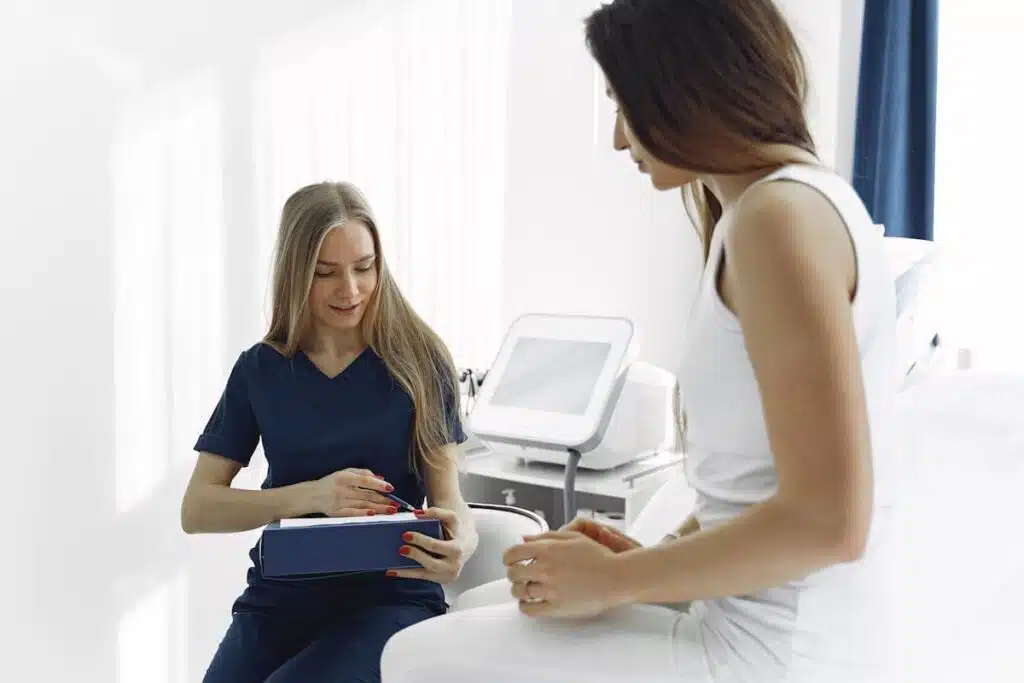What if there was a way to find relief from chronic pelvic pain and resume activities you enjoy? With pelvic congestion syndrome (PCS), it often feels like a hidden condition wreaking havoc. But various treatments can help overcome PCS.
This guide will empower you to understand the risk factors, causes, symptoms, diagnosis, and most importantly, the available treatments. While PCS may not yet have a definitive cure, the great news is that excellent patient outcomes frequently follow intervention for pain relief. There is hope to restore harmony from this burdensome syndrome.
What is pelvic congestion syndrome?
Pelvic congestion syndrome, also termed pelvic venous insufficiency, involves chronic pelvic pain lasting over 6 months. With PCS, problems occur with blood flow within pelvic veins, often tied to the ovaries.
Here’s what happens. Normally, blood travels upward from the pelvic veins toward the heart. But in pelvic congestion syndrome, valves inside these veins stop functioning properly. This causes blood to abnormally flow backward, known as reflux. As a result, the veins swell, twist, and overflow with blood. Ultimately, this pooled blood stretches the veins and potentially touches nearby pelvic nerves, provoking pain.
What are the symptoms of pelvic congestion syndrome?
The hallmark symptom is a dull, achy, or heavy pelvic pain persisting for over 6 months. Sometimes the discomfort feels sharp. The pain frequently starts during or after pregnancy, possibly worsening with future pregnancies.
You may notice this stubborn pain:
- On the left side
- On the right side
- Both sides
- The lower abdominal or pelvic area
Additionally, those with PCS often endure:
- Varicose veins in the pelvis, thighs, or vulva
- Bouts of diarrhea and constipation
- Accidentally peeing from sudden movements
- Painful urination
- Discomfort standing or sitting for prolonged times
If any of these PCS symptoms sound familiar, don’t ignore them. Getting an accurate diagnosis is the critical next step toward relief.
What causes pelvic congestion syndrome?
The exact cause of this condition remains unknown. However, the leading theory pinpoints pregnancy and estrogen imbalances.
To support fetal development, blood vessels must expand 50% more than usual during pregnancy. Researchers believe these extraordinary changes may permanently damage vein walls, keeping them abnormally dilated afterward. This makes sense since it is uncommon post-menopause when estrogen production decreases. Estrogen likely plays a role in influencing vein walls to become prone to defects enabling backward blood flow.
In summary, alterations occurring in blood vessels throughout pregnancy, combined with estrogen’s effects, can promote the vein valve disfunction and reflux central to pelvic congestion syndrome.
Risk factors for pelvic congestion syndrome?
You may have an increased pelvic congestion syndrome risk if:
- Between ages 20-45 years old
- Have birthed multiple children
- Possess a family history of varicose veins
- Have polycystic ovarian syndrome (PCOS)
How healthcare provider diagnose PCS?
Because so many conditions cause chronic pelvic pain, diagnosing the root cause can be complicated. Your doctor will start with a full medical history, physical exam, and pelvic exam to help rule out other possible explanations for your symptoms.
Be prepared to share details about your pain, menstrual cycles, past pregnancies, digestive issues, sexual health, family history, and any relevant events. This comprehensive picture will point your doctor toward an accurate PCS diagnosis.
Your doctor will likely order imaging tests to confirm PCS by detecting enlarged, twisted pelvic veins, backward blood flow, blood pooling, and vein leakage:
- Pelvic Ultrasound: This standard first test checks for ovarian cysts and enlarged pelvic veins with Doppler imaging to assess blood flow.
- CT Scan or MRI: Provides detailed views of pelvic veins to locate size, swelling, twisting, pooling of contrast dye.
- Pelvic Venography: A catheter injects contrast dye to make vein issues clearly visible via x-ray. Considered the gold standard for diagnosing PCS.
- Laparoscopy: A tiny camera inserted through a small abdominal incision helps rule out other causes of pelvic pain.
Getting diagnosed may take patience and persistence since each woman’s case is unique. But an accurate PCS diagnosis puts you firmly on the path to solutions.
Treatment options
While no definitive cure exists for pelvic congestion syndrome presently, excellent patient outcomes follow treatments easing associated chronic pain. Your healthcare provider will likely first recommend medication before considering surgery.
Medications Helpful for Symptoms Relief
- Birth control pills or injections lowering estrogen production
- GnRH analogs shutting down estrogen activation
Minimally invasive procedures
If you experience inadequate pain relief from medications, consider minimally invasive vein procedures performed through tiny incisions not requiring extensive recovery. Such options include:
Ovarian Vein Embolization – This procedure blocks problematic veins transporting blood backward through the pelvis. It involves a small tube (catheter) carefully guided into faulty ovarian veins and pelvic veins. Then, irritating chemicals, small coils, glue, or foam get injected inside the veins. This inflames and seals off the veins to prevent blood from pooling and nerves from triggering pain.
Laparoscopic Ovarian Vein Ligation – A trained surgeon ties off dilated ovarian veins laparoscopically through abdominal incisions using stiches. This stops blood reflux.
These minimally invasive procedures boast impressive success. Approximately 75% of patients undergoing ovarian vein embolization experience notable pain relief with only a 5% recurrence rate. Ask your doctor which option may be most effective for your individual case.
How to prevent pelvic congestion syndrome?
Unfortunately, pelvic congestion syndrome remains impossible to prevent presently. However, you can control risk factors within your influence, like avoiding tobacco use and maintaining regular exercise and a healthy diet to support vein health. Discuss your vein health history with your doctor before future pregnancies.
Take control of your pelvic health
Despite lacking a definitive cure for pelvic congestion syndrome currently, multiple safe and effective treatment options exist offering hope. Over 75% of patients find immense pain relief through minimally invasive procedures correcting faulty blood flow. This allows resuming cherished activities without chronic pain’s interference.
Arm yourself with the knowledge that pelvic congestion syndrome no longer means giving up what you enjoy. Work with a compassionate healthcare provider to find the optimal treatment plan. With a proactive approach, you can overcome PCS and reclaim your active lifestyle. The time for relief is now!



